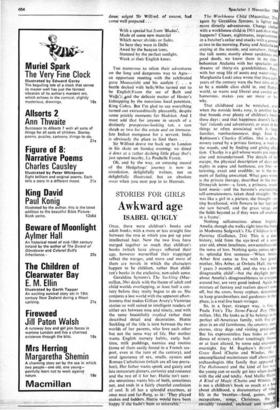STORIES FOR GIRLS
Awkward age•
ISABEL QUIGLY
Once, there were children's books and adult books, with a more or less straight line between the two at which you put up your intellectual hair. Now the two lives have merged together so much that children's books (which have always reflected their age, however nurserified their trappings) reflect the merger, and more and more of them are novels in which the characters happen to be children, rather than child- ren's books in the exclusive, non-adult sense.
Geraldine Symons's The Suckling (Mac- millan, 30s) deals with the theme of adult and child worlds overlapping, at least half a cen- tury before they really began to do so. She conjures a lost world with the apparent effort- lessness that makes Gillian Avery's Victorian stories so well suited to intelligent readers of either sex between nine and ninety, and with the same beautifully implied rather than described detail and decoration. Hattie Suckling of the title is torn between the two worlds of her parents, who love each other but not the same way of life. Her mother wants English nursery habits, early bed- time, milk puddings, nannies and routine (none of them easily found in a French sea- port, even at the turn of the century), and total ignorance of sex, smells, oysters and Roman Catholicism (which are all too preva- lent). Her father wants spunk and gaiety and late restaurant dinners, curiosity and romance and the rest of it for her. Hattie isn't sure : she sometimes wants bits of both, sometimes not, and ends in a fairly cheerful confusion of soul. It all has a splendid exactness, at once neat and far-flung, as in: 'They played snakes and ladders. Hattie would have been happy if she hadn't been so miserable.'
The Workhouse Child (Macmillan, 21s again by Geraldine Symons, is lighter and more directly adventurous. Change clothes with a workhouse child in 1911 and then What happens? Chases, nightmares, imprisonment in a butcher's cellar and snacks with a general at two in the morning. Pansy and Atalanta art staying at the seaside, and somehow. though the talk seems mostly about sandshoes and good deeds, we know them in no time: bohemian Atalanta with her spectacles and dreams of thirty-six grandchildren, Pansy with her snug life of aunts and water-wings. Marghanita Laski once wrote that these early years of the century were the best time of all to be a middle class child in, and Pansy's world, so warm and liberal and candid and humorous, makes you see more or less why.
That childhood can be wretched, even when the outside looks rosy, is another fact that broods over plenty of children's books these days ; and that happiness doesn't lie in `fun' (islands and adventures), or even in the things so often associated with it—large families, rumbustiousness, dogs. Joan G. Robinson's Charley (Collins, 16s) is about misery cured by a private fantasy, a week in the woods, and by finding and giving affec- tion. Charley is a girl whose wants are impre cise and misunderstood. The details of her escape, the physical description of days and nights in copse and henhouse, are fine—in- teresting, exact and credible; so is the tor- ment of feeling unwanted. What goes won. is the private therapy, described in the most Disneyish terms—a fawn, a princess, wood- land music—and the heroine's excruciatin self-consciousness, taken dead straight : 'Sh was like a girl in a picture, she thought—sil- ting barefooted, with flowers in her lap: and she saw herself, and the grass verge, and the fields beyond as if they were all enclosed in a frame'.
Nothing selfconscious about frightful Amelia, though she walks right into the fran in Modwena Sedgwick's The Children in di Painting (Gollancz, 21s). This is a case history, told from the eye-level of a seven year old, about loneliness, unwantedness and the sense of loss. Nothing quite comes up to its splendid first sentence—'When Amelia Arber first came to live with her grand mother, Mrs Arber, at Owletts Hall, she u 7 years 3 months old, and she was a mu disagreeable child'—but the daylight parts about Amelia's disagreeableness to everyon around her, are very good indeed. Again, th mixture of fantasy and realism doesn't corn- off, but the cross, bossy orphan, determin to keep grandmothers and gardeners in thet place, is a real live heart-wringer.
So, in a feyer, stranger way, is Gus LI Paula Fox's The Stone-Paced Boy (Ma millan, 18s). He looks as if he belongs to th perfect all-American family, with five chil dren in an old farmhouse, the country. soon storms, stray dogs and visiting great-aun But his expressionless face hides an abun dance of misery, rather touchingly than or at least altered, by some odd encounte overnight. Joy M. Bagshaw's Beyond th Grass Bank (Chatto and Windus, 180 uncomplicated mainstream stuff about youn archaeologists (the family that appeared The Hobstones) and the kind of hot was the young can so easily get into when deali with the old and tetchy. And Mollie Hams A Kind of Magic (Chatto and Windus, is not a children's book so much as a about childhood, a documentary of villa life in the 'twenties—food, games, sell' occupations, songs, Christmas, the enviably rounded, enclosed and comP














































 Previous page
Previous page